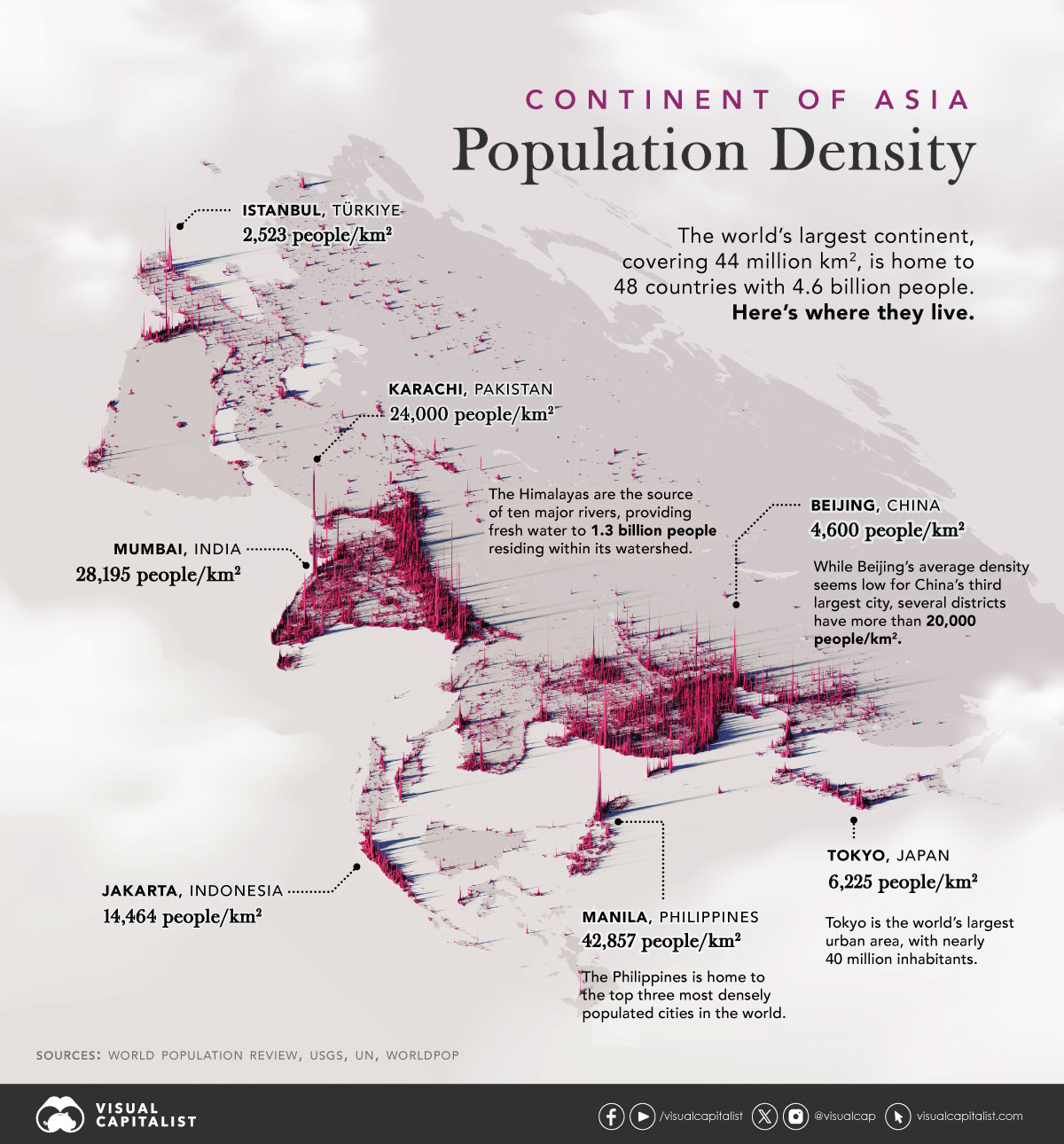Nearly 60% of the world’s 8 billion population lives in Asia: a vast continent sprawling over 44 million km², home to sprawling megacities, high-altitude deserts, the world’s biggest plateau, and impenetrable rainforests.
We visualize Asia’s population patterns using data from WorldPop—a research group based out of the University of Southampton that tracks population growth and movement across the globe.
A spike on the map denotes higher population density.
Other figures in this article are sourced from World Population Review (population numbers) and the World Bank (area).
Ranked: Asia’s Countries By Population
Immediately the map visualizes at impressive scale a rather well-known fact: that India and China together account for 35% of the world’s population just by themselves.
Pakistan (ranked 4th in population) and Bangladesh (ranked 5th) together account for another 400 million people.
The role of the Himalayas in this distribution is understated: the mountain range is a source of ten major rivers, flowing to India, Nepal, Bangladesh, Pakistan, and China, providing fresh water to 1.3 billion people in its watershed.
Note: Russia and Georgia are typically regarded as European countries for cultural reasons, despite their geographic locations. They have been included in the dataset for context only.Other countries that are covered by red: Indonesia (ranked 4th in population), Japan (ranked 7th), and the Philippines (8th), are all some of Asia’s most populous countries.
They also have some of the world’s densest cities:
- Manila: 42,857 people/km²
- Mumbai: 28,195 people/km²
- Karachi: 24,000 people/km²
- Jakarta: 14,464 people/km²
Tokyo and Beijing—despite being some of the world’s largest cities by population—record lower densities in comparison, helped by their much larger administrative areas.
But when sorted by average population density across the entire country, the ranks look a little bit different.
Ranked: Asia’s Countries By Population Density
The city state of Singapore is the densest country in Asia, with more than 8,000 people/km². Far behind it, the similarly sized in area Bahrain has one-sixth the population and ranks second (1,892/km²) in Asia’s densest countries.
Note: Russia and Georgia are typically regarded as European countries for cultural reasons, despite their geographic locations. They have been included in the dataset for context only.Bangladesh, with 1,180 people/km², has the rare distinction of being a top five Asian country by both population and average population density.
Meanwhile, India is 9th in population density (437 people/km²), its large landmass bringing down the average considerably.
Similarly, China nearly breaks into the top 20 with a population density of 149 people/km². Despite its vast population, the country’s immense size presents a challenge, particularly in its western regions, which are largely inhospitable to substantial human settlement due to the presence of mountains, the Tibetan plateau, and two deserts.
At the bottom of the rankings, Mongolia (2 people/km²) and Kazakhstan (7 people/km²) are some of the least dense countries in the world.
Asia’s Population Patterns by Density
March 23rd, 2024
March 23rd, 2024
Via Visual Capitalist, an interesting graphical look at Asia’s population patterns by density:

This entry was posted on Saturday, March 23rd, 2024 at 9:59 am and is filed under Uncategorized. You can follow any responses to this entry through the RSS 2.0 feed.
Both comments and pings are currently closed.
ABOUT
Focusing primarily on The New Seven Sisters - the largely state owned petroleum companies from the emerging world that have become key players in the oil & gas industry as identified by Carola Hoyos, Chief Energy Correspondent for The Financial Times - but spanning other nascent opportunities around the globe that may hold potential in the years ahead, Wildcats & Black Sheep is a place for the adventurous to contemplate & evaluate the emerging markets of tomorrow.
